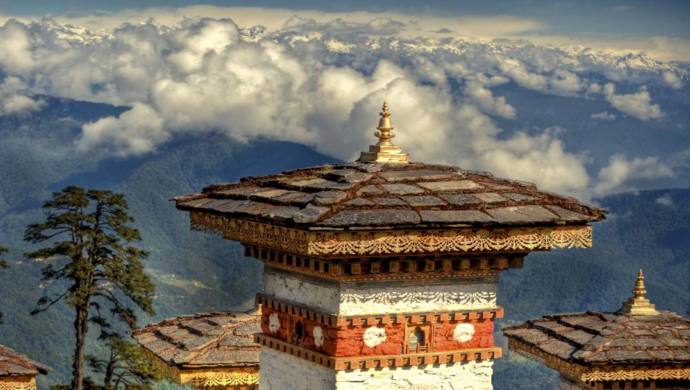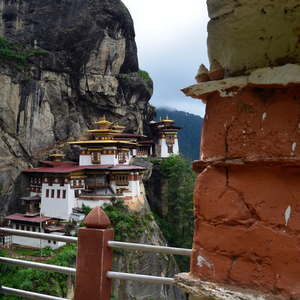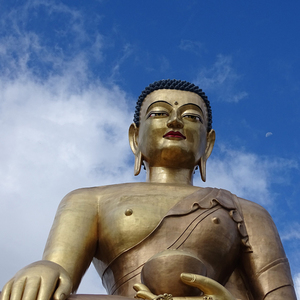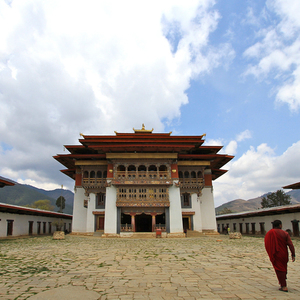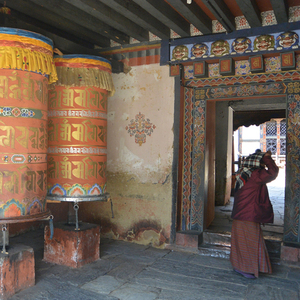Day 1. Paro - Thimphu:
Driving Distance: 65 Kms, Driving time: 1.50 hrs – 2 hrs, Altitude of Thimphu: 2,350 m
Your flight to Paro on a clear day, is marked with the panoramic views of the Himalayas including the Everest and other famous Peaks. The approach through the foothills and the landing (including few steep turns) at the tiny airstrip of Paro has been termed as adventurous by many travelers. After the completion of immigration formalities at the Paro Airport exit door, you will be received by your Bhutanese guide with traditional “Tashi Khadar”. Afterwards drive to Thimphu following the Pa Chhu River. Check-In to the hotel and have your first experience with Bhutanese Cuisine. Rest of the day is at leisure. You can explore the Thimphu valley and town or shop till your heart’s content. Enjoy a traditional cultural show arranged for you later in the evening. During the show you could also join in to get a feel of an important aspect of Bhutan.
Meals – Lunch and Dinner; Overnight at the Hotel in Thimphu.
Day 2. Thimphu Sightseeing:
Today you would be driven in and around Thimphu covering key places of interest. After breakfast you would visit
- Kuensel Phodrang, the gigantic Buddha Dordenma Statue located atop a hill in Kuensel Phodrang Nature Park.
- National Memorial Chhorten, a Stupa built in 1974 to honor the third Druk Gyalpo, Jigme Dorji Wangchuck. Every morning till night old people and young people circumambulate the Chhorten. You may choose to light butter lamps and also circumambulate around the Chorten.
- Zorig Chusom, Premier institute of traditional arts and crafts in Thimphu built of preserve “thirteen arts and crafts of Bhutan”.
- Folk Heritage, traditional house giving an insight to the Bhutanese lifestyle, and artifacts from the rural households
Thereafter you would be taken to a local restaurant for lunch. In the afternoon you would be taken to
- Sangaygang View Point, also known as BBS Tower offering panoramic view of Thimphu Town situated at an elevation of 2,685 m.
- Changangkha Monastery, popular fortress like temple perched on a ridge above Central Thimphu built in 15th Century by Lama Phajo Drugom Zhipo.
- Takin Preserve Centre, see Takin (National animal of Bhutan) It is a unique combination of Goat and an Antelope
- Tashichhodzong, or ‘the fortress of the glorious religion’. Initially erected in 1641 by Shabdrung Ngawang Namgyal, it was rebuilt in the 1960s during the reign of Bhutan’s third king in the traditional style, without plans or nails. It houses some ministries, His Majesty’s secretariat, and the central monk body and opens after 5 PM.
After the completion of sightseeing, you are driven back to your hotel. In the evening a preaching session with a Local High Priest (Lama). After the preaching session you shall be served with dinner.
Meals – Breakfast, Lunch and Dinner; Overnight at the Hotel in Thimphu.
Day 3. Thimphu Sightseeing:
After breakfast, drive to Tango Cheri Road in upper Thimphu through several villages. Relax and walk around the villages when in Dodena. You then hike to
- Cheri Monastery, was established in 1620 by Ngawang Namgyal, 1st Zhabdrung Rinpoche. The hike takes about 45 minutes. Apart from being one of the most beautiful monasteries, here we also have an option of meeting with the students and the monks. You would also be see pretty phalluses that are believed to ward of the evil.
Picnic Lunch shall be provided on the venue. Post lunch, you start you hike to
- Tango Monastery, was founded by Phajo Drugom Zhigpo in the 13th century and built in its present form by Tenzin Rabgye, the 4th Temporal Ruler in 1688. The hike to Tango Monastery also takes around 45 minutes and goes gradually uphill through alpine woods.
Return back to town by evening. By the end of the day, you shall have the opportunity to enjoy adventure, nature, culture and the way of life in Bhutan.
Meals – Breakfast, Lunch and Dinner, Overnight at the Hotel in Thimphu.
Day 4. Thimphu - Gangtey/Phobjikha:
Driving Distance: 140 Kms, Driving time: 4 hrs - 5 hrs, Altitude of Gangtey/Phobjikha: 2900 m
After breakfast and completion of check out formalities, you are driven to Gangtey/Phobjikha. On the way stop at
- Dochula Pass, lies at an elevation of 3,150 m and is a great place to view the higher Himalayas. The landmarks around the pass includes 108 Druk Wangyal Stupas built under the patronage of Queen Ashi Dorji Wangmo Wangchuk
Thereafter, you continue your drive to Gangtey/Phobjikha. Enroute stop for lunch. While in Gangtey, visit the
- Gangtey Goemba, an important monastery of Nyingmapa school of Buddhism, the main seat of the Pema Lingpa tradition. The present Abbot, Kunzang Pema Namgyal is the ninth re-incarnation. It is one of the the largest Nyingma monastery in Bhutan.
- Phobjikha Valley, one of the most beautiful glacial valleys in the Himalayas. It lies at an elevation of 3,000 m. It is surrounded by a large village inhabited mainly by the families of the 140 Gomchens who take care of the monastery. Phobjikha is best known for the rare black necked cranes that migrate here from the Tibetan Plateau to avoid the extremely cold winters.
You may choose to do any of the following: Visiting villages and interacting with People, Hikes around the valley, Photography, etc.
Later you are driven back to your hotel. After relaxing for sometime you are served with dinner.
Meals – Breakfast, Lunch and Dinner; Overnight at the Hotel in Phobjika/Gangtey.
Day 5. Gangtey - Trongsa - Bumthang:
Distance: 188 kms, Driving Time: 6 hrs - 7 hrs, Altitude of Bumthang: 2600 m.
After breakfast, check out from hotel and drive to Trongsa across Pele-La-Pass (11.120 ft.). Here you would witness an abrupt change in vegetation, with mountain forest replaced by high altitude dwarf bamboos. On the way stop at
- Chendbji Chhorten, built during the 18th century by Lama Shida in the style of the great Boudhanath Chhorten of Nepal to cover the remains of an evil spirit which is said to have manifested as a gigantic snake.
Further ahead visit
- Trongsa Dzong, the seat of power over Central and Eastern Bhutan. It was built by Chogyal Minjur Tempa was later enlarged at the end of the 17th century by Desi Tenzin Rabgay. Trongsa Dzong is the ancestral home of the present Royal Family. The first two hereditary kings ruled Bhutan from this Dzong.
- Ta Dzong, an ancient watch tower built in the year 1652 by Chogyal Minjur Tempaa as per the directions of Shabdrung Ngawang Namgyal. It has been converted into a museum and represents a tasteful blend of tradition and modernity.
Enroute stop for lunch in local restaurant. Later drive further to Bumthang over the Yutong-La-Pass (11,155 ft.). On arrival check in at the hotel. Evening free for leisure and walk in the valley.
Meals – Breakfast, Lunch and Dinner; Overnight at hotel in Bumthang.
(Note: the roads to Bumthang are not good due road widening work going on)
Day 6. Bumthang Sightseeing:
In the morning, drive to Chumey Valley and then hike to
- Tharpaling Monastery - Tharpaling, which means Land of Liberation, is the sacred site and retreat cave of the Longchen Rabjam (1308-1363). Longchenpa established the monastery at the base of Chodrak Cliff, one of Four Great Cliffs which had been blessed by Guru Rinpoche. The monastery contains statues of Longchenpa and Jikme Lingpa in meditation posture and frescoes of the lineage of Longchenpa and Jigme Lingpa. Above the Tharpaling Monastery (to the north) is Chodrak Monastery, a place where Guru Rinpoche is said to have meditated. It is about a 2-hour drive to the monastery on a rough road. From there you climbing on foot above the monastery to around 3,500 m to 4,300 m. Further walk for another couple of hours to Lama Goemba. The walk runs along the ridge of Kikila and finally follows the traditional trek route between Trongsa and Bumthang finishing with a wonderful view of Jakar Dzong. Your vehicle shall be waiting here to take you to hotel. Packed Lunch shall be provided.
On arrival check in at the hotel. Evening free for leisure and walk in the valley.
Meals – Breakfast, Lunch and Dinner; Overnight at hotel in Bumthang.
Day 7. Bumthang Sightseeing:
After breakfast, you would be taken around the city to visit the
- Jakar Dzong, literally meaning the Castle of White Bird. The current structure was built in 1667. Jakar Dzong is now the main administrative center for Bumthang District, the Dzong also houses the regional monk body.
- Jambay Lhakhang, built by King Srongsen Gampo of Tibet in the 7th century and is one among the 108 monasteries built by him to subdue evil spirits in the Himalayan Region. October one of the most spectacular festival, “Jambay Lhakhang Drup” is staged here.
- Chakhar Lhakhang, literally meaning the Iron Castle. The original palace was made of Iron and hence the name “Chakhar”. It was rebuilt in 14th century by Dorji Lingpa, a Buddhist saint.
- Kurjey Lhakhang, named after body print of Guru Rimpoche. It consists of three temples. The first temple was built in the year 1652 on the rock face, where Guru Padmasambhava meditated in the 8th century. The second temple is considered to be the most holy as it is built on the site of the cave which contains the imprint of the Guru's body. In the year 1990, Ashi Kesang, the Queen mother built the third temple. All the three temples are surrounded by 108 chorten wall.
Thereafter you would be taken to a local restaurant for lunch. In the afternoon you would be taken to
- Tamshing Lhakhang, literally meaning the Temple of the good message. It was established in 1501 by Terton Pema Lingpa and has ancient religious paintings such as 1000 Buddhas and 21 'Taras' (female form of Bodhisattva).
- Membar Tsho, also known as “The burning Lake”. It is one of the most sacred sites in the region and relates to the famous treasure revealer, Terton Pema Lingpa. Following a prophecy by Guru Rinpoche, Terton Pema Lingpa unearthed a treasure from the bottom of the lake. He dived into the lake with a burning butter lamp and reappeared with the butter lamp still burning and a chest and scroll of paper in his hand (Treasures or Terma)
The evening ends visit a local handloom weaving house and Interact with the weavers.
Meals – Breakfast, Lunch and Dinner; overnight at hotel in Bumthang.
With the extension of the duration of stay in Bumthang, more sacred temple and holy sites can be visited.
Day 8. Bumthang - Punakha/Wangdue:
Distance: 220 kms, Driving Time: 8 hrs - 9 hrs, Altitude of Punakha: 1310 m.
After breakfast, check out from hotel and drive to Punakha/Wangdue. On the way stop for Lunch. After arrival check into the hotel. Evening free for leisure.
Meals – Breakfast, Lunch and Dinner; Overnight at Hotel in Punakha/Wangdue.
Day 9. Punakha/Wangdue Sightseeing:
Today you would drive to (farm road is available, however may demand hike in some places)
- Bey Landra – Bey Landra is one of the three holiest nay (site) in Bhutan (the other two being Paro Taktsang and Singe Dzong). After driving through Wangdue towards Chuzomsa, you will follow a dirt road off to the left. On the way through the beautiful forests, you will pass many temples including the old Shaba Lhakhang where you can see a defined right foot print of Guru Rinpoche and beautifully carved hand-made wall-paintings. You will also pass a cave where water is dripping through the roof from what appears to be no source. Just before reaching the starting point for the hike, you will spot Guru Rinpoche’s walking stick; an enormous old Cypress tree stuffed with craftsmanship of great lamas. There are two big temples at the trail head; the upper one is a meditation retreat and the lower one, Yoser Namseling Lhakhang, is a two storied temple with beautiful sculptures of Guru Rinpoche’s eight manifestations. The path leading up to Bey Landra is partly through forests and on open meadows scattered with prayer flags. The cliff-hanging temple is a breathtaking sight even though it is currently being renovated and expanded. You will follow the same trail down.
It is believed that one day while in Tibet, Guru Rinpoche had a vision that people in the area where Bey Landra is now situated, were not practicing the Dharma and were engaged in doing evil. To put an end to this, he decided to travel here to reform the people. Whilst Guru Rinpoche was meditating here, the local evil spirit disguised himself as a red ox and attempted to distract and harm the Guru. Showing no compassion, Guru Rinpoche slaughtered the ox and later called upon his soul to make the evil spirit promise to stop harming the local people. Guru Rinpoche then concealed a total of 60 religious treasures into the rock which is now the wall of the temple, and gave the now liberated spirit the responsibility of guarding the hidden treasures. At present, the palm print of Guru Rinpoche, as well as an outline of a protective scorpion, is visible on the rock. The prophecy says that in the future a Terton (treasure discoverer) will come to reveal the valuable treasures. Directly translated, Bey Landra means – the hidden treasures in the ox rock. Packed Lunch shall be provided.
In the evening, drive back to hotel. Evening free for leisure.
Meals – Breakfast, Lunch and Dinner; Overnight at Hotel in Punakha/Wangdue.
Day 10. Punakha/Wangdue Sightseeing:
After breakfast, you would be visiting
- Khamsum Yulley Namgyel Monastery, a monastery that stands majestically on a strategic ridge above the Punakha valley. Built over a period of 9 years, Bhutanese craftsmen consulted holy scriptures rather than engineering manuals, to construct this 4-storey temple. It takes an hour to hike to the Temple passing through rice fields on the way.
After lunch, visit the
- Punakha Dzong, built in 1637 by Shabdrung Ngawang Namgyal. For many years until the time of the second King, it served as the seat of the Government. It is still the winter residence of Je-Khenpo (The Chief Abbot of the Central Monastic Body of Bhutan)
- Chhimi Lhakhang, a famous Temple, which is also known as “The Temple of Fertility” built by Lama Drukpa Kuenley.
After Chhimi Lhakhang, you would come back to your hotel. Evening free for leisure.
Meals – Breakfast, Lunch and Dinner; Overnight at Hotel in Punakha/Wangdue.
Day 11. Punakha - Paro:
Driving Distance: 135 kms, Driving Time: 4 hrs - 5 hrs, Altitude of Paro: 2280 m
After early breakfast, you would check out of the hotel to proceed to Paro, final leg of the tour. On the way stop at
- Tamchog Lhakhang (between Paro and Thimphu); built in the 13th century by Thangtong Gyalpo. He is also known as the Iron bridge builder. Situated on a hill top, we have to cross an ancient style bridge to reach the temple. It is owned by the descendants of Thangtong Gyalpo.
After arriving at Paro, you would be transferred to you Hotel for Check In. After lunch, you would be taken around for hike to
- Dra Karpo, an important pilgrimage place. Like the Paro Taktsang, it is associated with Guru Rinpoche. It is one of the many places in Bhutan where Guru Rinpoche is said to have meditated while he was in Bhutan. In the temple you can see a huge stone which the Guru, according to legend, shifted from the mountain side to make space for the intimate altar room. The views from the temple are breath taking with an immediate drop down to Paro valley. A place of Tshering Ma (goddess of long life) below the temple is considered to be the gateway to the sacred place. The hike takes around 1 - 2 hours to complete and 30 - 45 minutes to come back.
Evening is free for leisure activities and shopping.
Meals – Breakfast, Lunch and Dinner; Overnight at the Hotel in Paro.
Day 12. Paro Sightseeing:
After an early breakfast, start your day with a hike to
- Chumphug Monastery, also known as Chumophug, situated at 3100m above sea level. Among other numerous sacred sites, the main relic is the self-arisen image of flying Vajrayohini or Dorji Phagmo. There are numerous marks and prints of Guru Padmasambhava. It is said that Guru Rimpoche meditated here for 3 months. Hike to Chumphug Nye starts from the Upper Dop Shari Valley after a drive for about half an hour on the dirt road from Paro till its end. Then keep walking along the river till you get to a place where there is a small chorten (stupa). On the way you would come across to many holy and religious sites which will be explained by the guide. We would then have to hike uphill for about 45 minutes to reach the main temple. The total is of 4 - 5 hours from the main road. You would also see the statute of Dorji Phagmo, which is believed to be in the air. After visiting the temple, we would start our hike back through the same road and would stop for a picnic lunch near the river, after lunch we carry on with our hike until the starting point. It takes about 2 - 3 hours to reach the main road.
Evening free for relaxation.
Meals – Breakfast, Lunch and Dinner; Overnight at the Hotel in Paro.
Day 13. Paro Sightseeing:
After breakfast, start your day with a hike to
- Taktsang Monastery (Tiger's nest), the abode of gods and monks situated at an altitude of 3100m on the Upper Paro Valley, Bhutan. As per the legend, Guru Padmasambhana (Guru Rinpoche), the tantrum mystic who brought Buddhism to Bhutan, came in the form of Dorje Droloe riding a flying tigress to subdue the demon that was obstructing the spread of Buddhism in the Himalayas. This is the most important holy site of Bhutan.
After the completion of the hike, you would be served picnic Lunch among the woods. After lunch, visit
- Kyichu Lhakhang, one of the oldest monasteries in Bhutan built in the 7th century by the Tibetan Emperor Songtsen Gampo
- Paro Rimpung Dzong, also known as Fortress of the heap of jewels, built during the time of Shabdrung Ngawang Namgyal in 1646
You would then drive to village house to witness the traditional rural life in a Bhutanese village. Also you have an option of experiencing a Traditional Hot Stone bath in the village house. You can also choose to have your dinner in the house with the Family (needed to be confirmed at the time of confirmation of the Tour) or be driven back to your hotel.
Meals – Breakfast, Lunch and Dinner; Overnight at the Hotel in Paro.
Day 14. Departure:
Today we will bid farewell to this beautiful country and take an early flight back. We hope by now you must have made some good friends and also have taken photographs and beautiful memories of Bhutan. We certainly hope of serving you again on your next visit to this great country or the Last Shangri-La. Tashi Delek.
